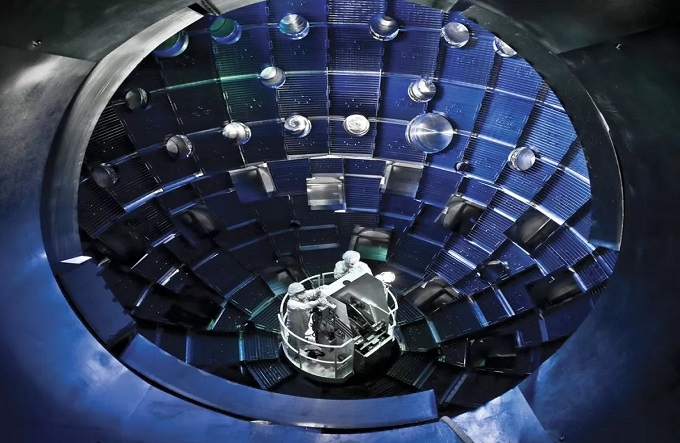
A major breakthrough has been announced by US scientists in the race to recreate nuclear fusion.
Physicists have pursued the technology for decades as it promises a potential source of near-limitless clean energy.
On Tuesday researchers confirmed they have overcome a major barrier – producing more energy from a fusion experiment than was put in.
But experts say there is still some way to go before fusion powers homes.
The experiment took place at the National Ignition Facility at the Lawrence Livermore National Laboratory (LLNL) in California.
LLNL director Dr Kim Budil said: « This is a historic achievement… over the past 60 years thousands of people have contributed to this endeavour and it took real vision to get us here. »
Nuclear fusion is described as the « holy grail » of energy production. It is the process that powers the Sun and other stars.
It works by taking pairs of light atoms and forcing them together – this « fusion » releases a lot of energy.
It is the opposite of nuclear fission, where heavy atoms are split apart. Fission is the technology currently used in nuclear power stations, but the process also produces a lot of waste that continues to give out radiation for a long time. It can be dangerous and must be stored safely.
Nuclear fusion produces far more energy, and only small amounts of short-lived radioactive waste. And importantly, the process produces no greenhouse gas emissions and therefore does not contribute to climate change.
But one of the challenges is that forcing and keeping the elements together in fusion requires very high temperatures and pressures. Until now, no experiment has managed to produce more energy than the amount put in to make it work.
How close is a fusion-powered future?
The amount of energy they’ve generated in this experiment is tiny – just enough to boil a few kettles. But what it represents is huge.
The promise of a fusion-powered future is one step closer. But there’s still a long way to go before this becomes a reality.
This experiment shows that the science works. Before scientists can even think about scaling it up, it needs to be repeated, perfected, and the amount of energy it generates will have to be significantly boosted.
This experiment has cost billions of dollars – fusion does not come cheap. But the promise of a source of clean energy will certainly be a big incentive for overcoming these challenges.

The National Ignition Facility in California is a $3.5bn (£2.85bn) experiment.
It puts a tiny amount of hydrogen into a capsule the size of a peppercorn.
Then a powerful 192-beam laser is used to heat and compress the hydrogen fuel.
The laser is so strong it can heat the capsule to 100 million degrees Celsius – hotter than the centre of the Sun, and compress it to more than 100 billion times that of Earth’s atmosphere.
Under these forces the capsule begins to implode on itself, forcing the hydrogen atoms to fuse and release energy.
On announcing the breakthrough Dr. Marvin Adams deputy administrator for defense programs at the US National Nuclear Security Administration said that the laboratory’s lasers had input 2.05 megajoules (MJ) of energy to the target, which had then produced 3.15 MJ of fusion energy output.

Dr Melanie Windridge, CEO of Fusion Energy Insights, told the BBC: « Fusion has been exciting scientists since they first figured out what was causing the Sun to shine. These results today really put us on the path to the commercialization of the technology. »
Prof Jeremy P. Chittenden, professor of plasma physics and co-director of the Centre for Inertial Fusion Studies at Imperial College London called it « a true breakthrough moment ».
« It proves that the long sought-after goal, the ‘holy grail’ of fusion, can indeed be achieved, » he said.
This has been the sentiment echoed by physicists globally, who praised the work of the international science community.
Prof Gianluca Gregori, Professor of Physics at the University of Oxford said: « Today’s success rests upon the work done by many scientists in the US, UK and around the world. With ignition now achieved, not only fusion energy is unlocked, but also a door is opening to new science. »
On the question of how long before we could see fusion being used in power stations, Dr Budil, the LLNL director, said there were still significant hurdles but that: « with concerted efforts and investment, a few decades of research on the underlying technologies could put us in a position to build a power plant ».
This is progress from when scientists used to say 50 – 60 years in answer to that question.
One of the main hurdles is getting cost down and scaling up the energy output.
The experiment was only able to produce enough energy to boil about 15-20 kettles and required billions of dollars of investment. And although the experiment got more energy out than the laser put in, this did not include the energy needed to make the lasers work – which was far greater that the amount of energy the hydrogen produced.
World Opinions – BBC News




 World Opinions Débats De Société, Questions, Opinions et Tribunes.. La Voix Des Sans-Voix | Alternative Média
World Opinions Débats De Société, Questions, Opinions et Tribunes.. La Voix Des Sans-Voix | Alternative Média




